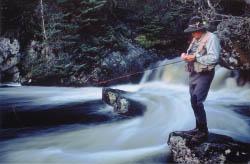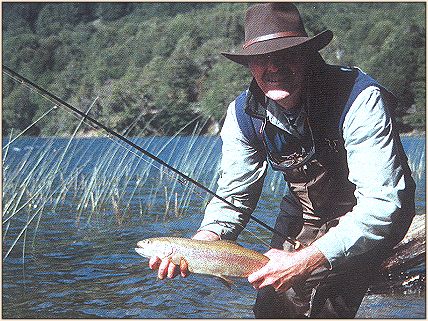Snowbirds in Patagonia
Parque Nacional Lanin: The Patagonian Lake District

By Chris Marshall
Photo by Duncan Hardie
The rivers and lakes of Parque Nacional Lanin offer
fly fishing reminiscent of that found in the Rockies
and foothills 60 years ago. The park, situated in
northern Patagonia 1,200km south of Buenos Aries, is
sparsely populated and remote from any large urban
areas. Consequently, angling pressure is minimal by
North American standards. Yet, within its boundaries,
there are scores of lakes and countless rivers which
teem with wild brown and rainbow trout. In a few,
there are also populations of North American brook
trout and landlocked Atlantic salmon.
The region is ideal for Canadian fly fishers seeking
relief from cabin fever during the long winter. The
Patagonian trout season opens on November first and
runs until the end of April. In the early season, the
rivers run high and cold with snow-melt from the
mountains, but the trout are hungry and respond
aggressively to streamers and lures such as Woolly
Buggers and Zonkers fished deep on sink-tip lines.
As water levels recede in December, opportunities
for fishing nymphs and dry flies increase. The prime
months are January and February, which offer the widest
opportunities for fishing both floating and sinking
flies. Though March and April, the rivers begin to
cool again and water levels are at their lowest, and
while there are still plenty of opportunities for casting
a dry fly, sunk flies come into their own again.
None of the fish targeted by fly fishers are native
to South America. The browns were introduced from Europe
in the early twentieth century. One Patagonian we met
claimed that there was also a stocking from Australia.
There is a stronger claim for the landlocked salmon
originating from Sebago Lake in Maine, a claim which
is currently being researched by Ontario Ministry of
Natural Resources biologist, Jack Imhof. We had hoped
to find that at least some of the brook trout introduced
had come from Canada, but the source appears to be entirely
New England. All these species have adapted well to
Patagonian rivers and lakes, so that today there are
thriving wild populations throughout the region. Besides
the immigrant salmonids, there is one native species
which is taken incidentally by fly fishers using deeply
sunk flies, the perca (Percichthys trucha).

Fishing Sampler
One of the things which makes fly fishing in the Lanin
National Park unique, is the tremendous diversity of
the terrain, within an hour's drive of San Martin Des
Andes, at the heart of the park, there are semi-desert
foothills, wooded alpine valleys, snow capped
mountains-and just about everything in between. The four
rivers and one lake we fished during our short stay
provided a good sample of this diversity.
The headwaters of the Rio Malleo, where we fished on our
first and last evenings, flow through a wide, high-mountain
pass where the gradient is relatively gentle. Its smooth,
willow-lined pools and riffles provide classic dry fly
water. Here, we were rewarded with some of the best dry
fly fishing we've ever experienced-prolific hatches,
scores of rising fish, and just the right degree of
difficulty to provide challenge with minimum frustration.
Seventy kilometres to the east, where the Malleo joins
with the Rio Alumine and Rio Chimehuin to form the Rio
Collon Cura, the landscape is dramatically changed. The
Collon Cura flows through arid, semi-desert, its lush
green banks a stark contrast to the dusty yellows and
browns of the scrubland beyond. This is big water, best
fished from a drift boat, and we spent a day floating
close to 20km down it in an inflatable rigged with a
frame providing seats for two anglers and a rower. We
took browns and rainbows fishing both floating and
sinking flies to lies along the banks, drop-offs, and
the edges of the current. But if, like me, you find
things happen too quickly when you're fishing from a
moving boat, stopping and wading provides just as much
action-and the time to savour it.
A short drive south of San Martin de los Andes lies
the valley of the Rio Filo Hua Hum-a level valley of
meadow dotted with clumps of trees and wild flowers,
flanked by the steep, tree-clad shoulders of mountains,
rising to bare ochre sandstone and patches of snow. The
river, which drains two lakes close the Chilean border,
winds through it. With banks fragrant with oregano and
studded with fuschia and flowering vines, it is so utterly
beautiful that the wild browns and rainbows we caught
there were almost incidental.
As well as sections with pools and cascades, the Filo Hua
Hum has extensive pocket water, which provides superb
nymph fishing. It was here, around sunset, that I took
my biggest brown of the day, a powerful 22" fish, which
careened through the fast water until my wrists ached.
As we were leaving, we were inspected by a condor, wheeling
high above us, dark against the evening sky-a transcendent
moment at the closing of a perfect day.

The lakes range from the huge Lago Lacar at San Martin
and Lago Huechulafquen to the north, to medium-sized
meadow lakes, small, high-altitude, alpine lakes, and
tiny pockets of a few score acres. The biggest lakes
are not particularly popular among fly fishers, who
prefer medium-sized and smaller waters. It was on one
of these, Lago Escondido, a small alpine lake, that we
had our best stillwater fishing. It was only about 20km
from the lodge, but it took over an hour to reach it
by Land Rover over a track worthy of some of the
northern Quebec logging trails I've encountered. It
wound through steep, narrow valleys overhung with huge
lenga and coihue trees festooned with Spanish moss. The
lake is nestled between steep mountain slopes, but the
eastern end, where we launched the inflatable, was
ringed with reed-fringed shallows. Here, at the edges
of the reeds, we fished adult dragonfly imitations,
tied by our guide, Gustavos Pucci, on the surface for
rainbows and browns gorging themselves on ovipositing
naturals. The fish were not huge by Patagonian standards
(the largest was a 20" rainbow), but they were
breathtakingly muscular and acrobatic, making multiple
leaps and sometimes streaking so far out into deep water
that they took us into the backing.
In five days we fished four rivers and one lake-and we
barely scratched the surface-a mere 25% of those offered
by our outfitter, Ten Rivers Ten Lakes, and an even smaller
fraction of the rivers and lakes in the area. The extent
and diversity of fishing available in this one small corner
of Patagonia would take a whole season to sample thoroughly.
~ Chris Marshall
To Be Continued.....
Our Man In Canada Archives
|

